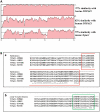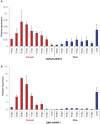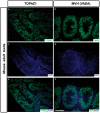TOPAZ1, a novel germ cell-specific expressed gene conserved during evolution across vertebrates
- PMID: 22069478
- PMCID: PMC3206057
- DOI: 10.1371/journal.pone.0026950
TOPAZ1, a novel germ cell-specific expressed gene conserved during evolution across vertebrates
Abstract
Background: We had previously reported that the Suppression Subtractive Hybridization (SSH) approach was relevant for the isolation of new mammalian genes involved in oogenesis and early follicle development. Some of these transcripts might be potential new oocyte and granulosa cell markers. We have now characterized one of them, named TOPAZ1 for the Testis and Ovary-specific PAZ domain gene.
Principal findings: Sheep and mouse TOPAZ1 mRNA have 4,803 bp and 4,962 bp open reading frames (20 exons), respectively, and encode putative TOPAZ1 proteins containing 1,600 and 1653 amino acids. They possess PAZ and CCCH domains. In sheep, TOPAZ1 mRNA is preferentially expressed in females during fetal life with a peak during prophase I of meiosis, and in males during adulthood. In the mouse, Topaz1 is a germ cell-specific gene. TOPAZ1 protein is highly conserved in vertebrates and specifically expressed in mouse and sheep gonads. It is localized in the cytoplasm of germ cells from the sheep fetal ovary and mouse adult testis.
Conclusions: We have identified a novel PAZ-domain protein that is abundantly expressed in the gonads during germ cell meiosis. The expression pattern of TOPAZ1, and its high degree of conservation, suggests that it may play an important role in germ cell development. Further characterization of TOPAZ1 may elucidate the mechanisms involved in gametogenesis, and particularly in the RNA silencing process in the germ line.
Conflict of interest statement
Figures












Similar articles
-
TOPAZ1, a germ cell specific factor, is essential for male meiotic progression.Dev Biol. 2015 Oct 15;406(2):158-71. doi: 10.1016/j.ydbio.2015.09.002. Epub 2015 Sep 7. Dev Biol. 2015. PMID: 26358182
-
Conserved and divergent patterns of expression of DAZL, VASA and OCT4 in the germ cells of the human fetal ovary and testis.BMC Dev Biol. 2007 Dec 18;7:136. doi: 10.1186/1471-213X-7-136. BMC Dev Biol. 2007. PMID: 18088417 Free PMC article.
-
Developmental stage- and germ cell-regulated expression of a calcium-binding protein mRNA in mouse Sertoli cells.Mol Reprod Dev. 1999 Nov;54(3):232-43. doi: 10.1002/(SICI)1098-2795(199911)54:3<232::AID-MRD4>3.0.CO;2-F. Mol Reprod Dev. 1999. PMID: 10497345
-
Expression of KIT in the ovary, and the role of somatic precursor cells.Prog Histochem Cytochem. 2011 Nov;46(3):131-84. doi: 10.1016/j.proghi.2011.09.001. Epub 2011 Oct 2. Prog Histochem Cytochem. 2011. PMID: 21962837 Review.
-
Meiosis and retinoic acid in the mouse fetal gonads: An unforeseen twist.Curr Top Dev Biol. 2025;161:59-88. doi: 10.1016/bs.ctdb.2024.10.006. Epub 2024 Oct 29. Curr Top Dev Biol. 2025. PMID: 39870439 Review.
Cited by
-
A high resolution atlas of gene expression in the domestic sheep (Ovis aries).PLoS Genet. 2017 Sep 15;13(9):e1006997. doi: 10.1371/journal.pgen.1006997. eCollection 2017 Sep. PLoS Genet. 2017. PMID: 28915238 Free PMC article.
-
Validation of reference genes for real-time PCR of reproductive system in the black tiger shrimp.PLoS One. 2012;7(12):e52677. doi: 10.1371/journal.pone.0052677. Epub 2012 Dec 28. PLoS One. 2012. PMID: 23285145 Free PMC article.
-
A de novo paradigm for male infertility.Nat Commun. 2022 Jan 10;13(1):154. doi: 10.1038/s41467-021-27132-8. Nat Commun. 2022. PMID: 35013161 Free PMC article.
-
Structural and Functional Characterization of a Testicular Long Non-coding RNA (4930463O16Rik) Identified in the Meiotic Arrest of the Mouse Topaz1 -/- Testes.Front Cell Dev Biol. 2021 Jul 1;9:700290. doi: 10.3389/fcell.2021.700290. eCollection 2021. Front Cell Dev Biol. 2021. PMID: 34277642 Free PMC article.
-
Genomic study and Medical Subject Headings enrichment analysis of early pregnancy rate and antral follicle numbers in Nelore heifers.J Anim Sci. 2017 Nov;95(11):4796-4812. doi: 10.2527/jas2017.1752. J Anim Sci. 2017. PMID: 29293733 Free PMC article.
References
-
- McLaren A. Germ and somatic cell lineages in the developing gonad. Mol Cell Endocrinol. 2000;163:3–9. - PubMed
-
- Pepling ME, de Cuevas M, Spradling AC. Germline cysts: a conserved phase of germ cell development? Trends Cell Biol. 1999;9:257–262. - PubMed
-
- Pepling ME. From primordial germ cell to primordial follicle: mammalian female germ cell development. Genesis. 2006;44:622–632. - PubMed
-
- Wartenberg H, Hilscher B, Hilscher W. Germ cell kinetics during early ovarian differentiation: an analysis of the oogonial cell cycle and the subsequent changes in oocyte development during the onset of meiosis in the rat. Microsc Res Tech. 1998;40:377–397. - PubMed
Publication types
MeSH terms
Substances
LinkOut - more resources
Full Text Sources
Molecular Biology Databases

